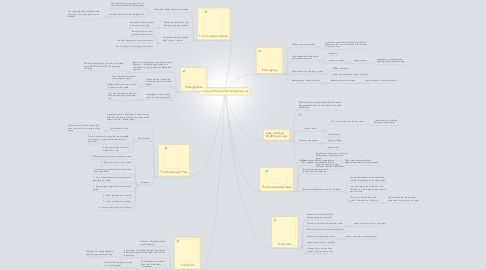
1. Cuneiform
1.1. Definition: The first form of a written language
1.2. It was written on a slab of clay that was wet and then made imprints with the stylus and then let the clay dry.
1.2.1. The stylus was wedge shaped to make the imprints into the clay
1.3. This language was made to keep track of business transactions
1.3.1. This was the new base of many to come languages
2. Hieroglyphics
2.1. Definition: The language used by the accent Egyptians. This language consisted of a combination of logographic and alphabetic elements.
2.1.1. The word Hieroglyphics come from the greek words HIERO-sacred GLYPHIC- engraving or writing
2.2. The people who learned the scribe were priest and military leaders
2.2.1. Priest learned it to perform many religious rituals.
2.2.2. Military leaders learned it to talk to the army will in battle
2.3. Hieroglyphics were normally found in tombs and temples.
2.3.1. They were but there as rituals to help the dead get into the after life.
3. The Gutenberg Press
3.1. A printing press is a hand press in which ink was rolled over the raised surface of mobile handsets letters held with a wooden frame
3.2. Movibal text
3.2.1. FIrst founded in china
3.2.1.1. First made out of wood that would often crack under the pressure of the press
3.2.2. This is a system of printing that uses movable components to reproduce the elements of a document
3.2.3. It was created by pouring hot metal into a mold
3.3. Its impact
3.3.1. 1. Perfected script and made it easier to read
3.3.2. 2. Books were made more rapidly
3.3.3. 3. Information could be shared locally and around the world
3.3.4. 4. Cost of books decreased allowing more people to buy them
3.3.5. 5. Demand grew. population became more literate
3.3.6. 6. Book trade began to flourish
3.3.7. 7. economies became stronger
3.3.8. 8. Art and science began to flourish
4. The Linotype machine
4.1. Christopher Sholes created the machine
4.1.1. He relized the first important users of the michine would be th stenograpers
4.1.2. He asked clephane to test his typewriter
4.1.2.1. The typewritter was not able to with stand the test so they made it more duribal
4.2. Sholes invention lead to text being more easily produced
4.2.1. newspaper industray paper produced more paper
4.3. the keyboard for this machine had 3 types of columes
4.3.1. the blue colume was for puntiotion and numbers
4.3.2. The black keys were for lower case letters
4.3.3. The white keys were for upper case letters
5. Cave pantings 30,000 years ago
5.1. DefinitonThey are beautiful, detailed and colorful representations found on the inside of cave walls and ceilings.
5.2. Lascaux cave
5.2.1. This is one of the most famous caves.
5.2.1.1. It was closed to to dioxide damage to the pantings
5.3. 3 reasons why created
5.3.1. To tell a story
5.3.2. Religious/Magic
5.3.3. instructional
5.4. Supplies
5.4.1. Brushes were created by combining sticks, stones, animal hairs, and leaves.
5.4.2. Paint was made by mixing plants, animal blood, and water
6. The Phonetic Alphabet
6.1. This alphabet, like the hieroglyphics, has a picture that represents a sound
6.1.1. This is why one theory that this alphabet originated from hieroglyphics
6.2. This text was read from left to right just like text nowadays
6.3. the greek alphabet came from this alphabet
6.3.1. the greek alphabet was considered the first true alphabet because it had vowels
6.3.2. they also created the serif which is the finishing of a stroke which made the text easier to read
6.3.3. They also made the base line, which is were the most letters sit
6.3.3.1. this made the text be in perfect alignment making it easier to read
7. Photograpy
7.1. What is a camera obscura?
7.1.1. a dark room with a lense inserted into a side of the rooma dark room with a lense inserted into a side of the room
7.2. Who invented the first practical photographic process?
7.2.1. Daguerre
7.2.2. what was it called
7.2.2.1. Daguerreotype
7.2.2.1.1. exposed to a metal sheet that would light was show an image
7.3. Who invented the Calotype process
7.3.1. William Fox talbot
7.3.2. image was exposed to a piece of paper
7.4. what company did eastman start
7.4.1. the eastman kodak company
7.4.1.1. they first created the bronie camera
8. computers
8.1. Konrad Zuse invented the first freely programing computer
8.2. The first commercial computer was univac
8.2.1. it stands for universal auto computers
8.3. IBM is international business management
8.4. Microsoft introduced the ms-dos
8.4.1. it was a computer operating system

